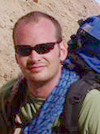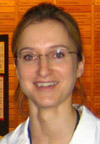
|
Tina Albertson
Undergraduate: University of Oregon
Medical School: Stanford University
Research Lab: Dr. Brad Preston
|

|
Leslie Caromile
Undergraduate: University of Connecticut
Research Lab: Dr. Dan Bowen-Pope
|
| Genetic instability is thought to be a major driving force in tumorigenesis. I am studying the role of Polymerase proofreading and mismatch repair (MMR) in mutation avoidance and tumor suppression. Previous members of the Preston lab have created mice that are deficient in the proofreading function of Polymearse delta and epsilon, the two main replicative polymerases in eukaryotic cells. These mice are cancer prone, and they get unique kinds of cancer, suggesting that they have different cancer suppression roles in mammals. I am studying how these enzymes interact with each other, genetically, and how they cooperate with MMR to suppress cancer and mutations in mice. |
Phogrin and IA-2 are proteins that localize to insulin-containing secretory granules in pancreatic beta cells. This suggests that they play some role in regulating insulin secretion, but no enzymatic activity for Phogrin has ever been reported. In preliminary studies, we have found that Phogrin is able to dephosphorylate specific inositol phospholipids. Domains that bind these phospholipids serve to localize specific proteins to the correct vesicle compartment and this regulates the formation and release of
secretory vesicles. My thesis project is to confirm the enzymatic activity of Phogrin, determine the activity of IA-2, and test the hypothesis that Phogrin plays a role in regulating insulin release by maintaining a gradient of PIP levels between secretory vesicles and the plasma membrane. The proposed enzymatic activities of Phogrin and IA-2 provide steps at which the secretory pathway for insulin release may be mis-regulated in diabetes and/or manipulated for clinical benefit. I will also investigate our labs
preliminary observation that modest elevation of circulating insulin levels, within the range found in type 2 diabetic patients, upregulates expression of Phogrin in vascular smooth muscle cells in injured vessels. This is the first observation of Phogrin expression outside of neuroendocrine cells. I will test the hypothesis that elevated insulin levels specifically affect smooth muscle cells in injured vessels and that this might play a
role in arterial disease in type 2 diabetic patients.
|

|
Bethany Cool
Undergraduate: Virginia PolyTech Institute
Research Lab: Dr. George Martin
|

|
Dao-Fu Dai
Undergraduate: National Taiwan University
Medical School: Kaohsiung Medical University
Research Lab: Dr. Peter Rabinovitch
|
| My research in Dr. Martinís lab focuses on the multi-modular
adaptor protein, FE65, which binds the cytoplasmic tail of the β-amyloid precursor protein (APP). Genetic evidence
suggests that APP is intimately involved in the pathogenesis of dementia of the Alzheimer type (DAT), a neurodegenerative
disorder or group of disorders that affects memory. FE65 also interacts with several other proteins, including
nonreceptor tyrosine kinase Abl, histone acetyltransferase Tip60, and transcription factor CP2/LSF/LBP1. Through these
interactions, FE65 may modulate gene expression. p97FE65-specific knockout mice (lacking the 97 kD FE65 protein,
p97) suggest an important role for FE65 in learning and memory (B.Wang et al., J.Neurosci.Res. 2004). Interpretation
of the learning and memory phenotype, however, is complicated by the up-regulation (compared to wild-type mice) of a
novel 60 kD FE65 isoform (p60). I am studying the functional differences between the p97 and p60 FE65 isoforms in
regards to the proposed role in the regulation of transcription, and am attempting to identify direct target genes that
may contribute, in part, to the phenotypes observed in p97FE65 knockout mice. |
Dr. Rabinovitch has developed several mouse models with extended longevity. My general interest in Dr. Rabinovitch's lab is to apply these mouse models to study the mechanisms of cardiac aging and the protective mechanisms against cardiac stresses such as ischemia-reperfusion injury and pressure-overloading. We are currently using mitochondrial-overexpressing mice to investigate the role of ROS in cardiac aging and other cardiac stresses. |

|
Will Driscoll
Undergraduate:
Research Lab: Dr. Elaine Raines
|

|
Richard Fox
Undergraduate: University of Washington
Research Lab: Dr. Steve Schwartz
|
| The Raines laboratory is examining the cellular and molecular mechanisms
involved in formation of lesions of atherosclerosis. The importance of
specific molecular pathways are tested in tissue culture and mouse models
using a combination of gene therapy and gene targeting approaches. Specific
pathways currently being investigated include: (1) regulation of endothelial
cell and monocyte adhesion molecules and ligands critical to the
inflammatory response by a family of proteases (ADAMs) that can rapidly shed
these molecules from the cell surface; (2) use of differential labeling and
proteomic approaches to identify novel substrates of ADAM17 and matrix
metalloproteinases identified in lesions of atherosclerosis. |
We demonstrate that rapamycin, a widely used anti-inflammatory
agent, appears to block a critical step in macrophage activation upon adherence. Macrophage adherence promotes rapid
and extensive changes in function that depend, in part, on non-lethal activation of caspases. One substrate processed
by activated caspases is Rho-associated kinase 1 (ROCK-1), a key molecule involved in cytoskeletal rearrangement and
morphogenic changes. Macrophages express ROCK-1 mRNA at constant levels; however, ROCK-1 protein is not present in
non-adherent macrophages. Following adherence, ROCK-1 protein rapidly accumulates and is enzymatically active.
mTOR/FRAP signaling is necessary for ROCK-1 translation. Following adherence, the efficiency of ribosome loading of
ROCK-1 messages increases. Direct inhibition of ROCK-1 or blockade of its synthesis by rapamycin, prevents
ROCK-1-dependent functions of macrophages in vitro, including cell spreading and chemotaxis. The rapid induction of
ROCK-1 protein and its proteolytic processing appear to be part of a rapid set of mechanisms required to direct the
macrophage phenotype upon attachment. |

|
Veronika Glukhova
Undergraduate: Western Washington University
Research Lab: Dr. Ray Monnat and Dr. Mike MacCoss
|

|
Jonathan Golob
Undergraduate: Johns Hopkins University
Research Lab: Dr. Chuck Murry
|
Mass spectrometry (MS) has become one of the most important tools in protein
studies. MS-based profiling is now a common method for discovery in
biological samples due to lack of bias inherent in antibody-based
approaches, and targeted proteomics is becoming an accepted method for
validation. However, the potential for the application of MS technology is
much wider than what is used in routine proteomic investigation. Basic
research in development of new protein analysis techniques is extremely
important for development of the field, discovery, and ultimately promoting
our understanding of biochemical processes.
The Monnat lab studies genetic instability and its relationship to cancer
and aging. As a model, I am using Werner syndrome, an inherited recessive
disease characterized by genetic instability, increased risk of cancer and a
premature aging phenotype. This syndrome is caused by a mutation in a human
RecQ helicase gene, which leads to the loss of function of its product
protein (WRN), making it an excellent system for study. My research goals
include application of MS technology to study WRN protein structure,
modification and interactions in order to understand the role of WRN in
biology and disease. We are also using this protein to develop new methods
and instrumentation for the analysis of protein chemistry related to
disease.
|
My research interests include transplant immunology, stem cell biology, the epigenetics of differentiation and gene transfer into mammalian cells. I am presently working towards a PhD degree in Dr. Charles Murry's laboratory, studying how cells establish and remember their identities. |

|
Allison Grabski
Undergraduate: Seattle Pacific University
Research Lab: Dr. Alec Clowes
|

|
Ingrid Harten
Undergraduate: Rutgers University
Research Lab: Dr. Tom Wight
|
|
Restenosis is the re-narrowing of an artery following vascular
trauma mediated by medial smooth muscle cell (SMC) infiltration
into the neointima and subsequent differentiation, migration,
proliferation and matrix synthesis. The molecular events which
initiate this cellular process remain unclear.
Sphingosine-1-phosphate (S1P) has recently emerged as highly
potent stimulus for several vascular SMC processes, primarily
obstructive artery disease. Previous data suggest deletion of one
of the three primary receptors for S1P in vascular SMCs, S1P2, leads to an increase in neointima formation following carotid
ligation in mice. The focus of my thesis project is to understand
the S1P2 dependent mechanism that inhibits neointimal growth.
Initial data suggest S1P mediated calcium increase is strongly
dependent on S1P2 but the calcium dependent signaling pathways
have yet to be resolved. The role of S1P2 and calcium in the
injury response will be evaluated by investigating differences in
gene expression between the normal and injured states, attempting
to identify key genes regulated by S1P2 and calcium. |
My research in Dr. Wight's lab focuses in general on the role of proteoglycans in atherosclerosis.
My project involves studying a model of accelerated atherosclerosis in children, which occurs in the absence of overt
blood lipid abnormalities, called Hutchinson Gilford Progeria Syndrome. This disease is a rapid aging syndrome caused
by specific mutations in the nuclear envelope protein called Lamin A. Through the use of an animal model and cell
culture systems we hope to characterize the proteoglycan abnormalities which contribute to the process of accelerated
atherosclerosis and perhaps uncover some links between these molecules and the aging process in general. |

|
Matt Holdren
Undergraduate: University of Washington
Research Lab: Dr. Dan Bowen-Pope
|

|
Jenny Kanter
Undergraduate: University of Linkoping, Sweden
Research Lab: Dr. Karin Bornfeldt
|
| My research centers on a family of proteins involved in the intracellular transport of receptors. These proteins, the sorting nexins, were initially thought to interact directly with receptors and direct their movement within the cell. My work has shown that it is more likely that the sorting nexin proteins are involved in formation of transport vesicles at the early endosome, which allow the receptors to then be transported in the cell. Recently my work has taken two directions; the first is the biochemical characterization of the "sorting complex" at the early endosome, while the second focuses on the physiological effects of sorting nexin depletion in cell lines. This second focus is based on my findings that protein levels of several of the sorting nexins are reduced in cancerous lesions, most significantly sorting nexin one levels in colon adenocarcinomas where over 70% of the patients analyzed showed complete loss of the protein. |
My project in Dr. Karin Bornfeldt's laboratory focuses on diabetes-accelerated atherosclerosis. More specifically I work on an enzyme called Long-chain Acyl-CoA syntetase 1 that converts fatty acid into a fatty acid-CoA, which can than be utilized by the cell. I have focused my work on this enzyme in macrophages, one of the major cell types in atherosclerosis, and its role as an important mediator of the increased fatty acid load seen in the diabetic state. |

|
Paul Keire
Undergraduate: University of Washington
Research Lab: Dr. Tom Wight |

| Xin Li
Undergraduate: Tianjin University
Research Lab: Dr. Karin Bornfeldt
|
| I am studying the proteoglycan component of vascular tissue and how it is possible to control the expression of PG molecules, and thus impact the cell phenotype, and engineer extracellular matrix (ECM) composition and organization. PGs are ECM components that are important in the formation of stable and organized biological matrices. In the Wight laboratory, we have found that when the ECM proteoglycan, versican V3, is overexpressed in vascular smooth muscle cells, elastic fibers form both in cell culture, and in vivo, when the V3 transduced cells are seeded into injured arteries. Failure of elastic fibers to form in bioengineered constructs or reform in tissue healing, is a limitation in tissue engineering and human disease. My thesis project focuses on the PG component of vascular tissue and uses molecular and genetic approaches to 1) better understand the biology of versican modulated elastogenesis, and 2) express specific versican isoforms by smooth muscle and fibroblast cells to assemble experimentally defined combinations of extracellular matrix (ECM) for the purpose of tissue engineering a blood vessel. |
My project focuses on the effects of fatty acid accumulation in endothelial
cells, which we believe might mediate some of the endothelial dysfunction
associated with diabetes. Specifically, I'm studying fatty acid transporter
protein 1 (FATP1), which increases fatty acid uptake, esterification, and
partitioning into cellular lipids. My hypothesis is that FATP1 plays a role in
fatty acid partitioning and endothelial dysfunction under conditions of
hyperlipidemia and diabetes. |

|
Ryan McMahan
Undergraduate:
Research Lab: Dr. Nelson Fausto
|

|
Thomas Nhan
Undergraduate: University of Washington
Research Lab: Dr. Steve Schwartz
| TNF-α converting enzyme (TACE) has recently been identified as a key matrix metalloproteinase (MMP) and physiological convertase with a number of targets that play critical roles in cytokine and growth factor signaling pathways. These complex and interdependent pathways have been shown to be essential components of the signaling network that links liver function with the compensatory hyperplasia that occurs during liver regeneration following partial hepatectomy (PH) or chemically-induced hepatotoxicity. Increased activation of several MMPís has been shown to occur following PH, and their established roles in growth factor bioavailability suggest they may be key regulators of liver regeneration. Recent studies have shown TACEís primary target, TNF, must bind its receptor on hepatocytes to initiate the cytokine network in regeneration following PH, but can also exacerbate liver damage with excess stimulation following acetaminophen or carbon tetrachloride-induced hepatotoxicity. Our own in vitro studies have implicated TACE as a mediator of TNF-induced transactivation of EGFR, which subsequently signals for proliferation during initiation of liver regeneration. The studies in my project aim to define the in vivo role of TACE in liver regeneration using a novel, hepatocyte-specific TACE KO mouse model and well-established protocols of liver injury: 2/3 PH, and APAP and CCl4-induced hepatotoxicity. |
Fusion of macrophages into multinucleated giant cells (MGC) is an
important chronic inflammatory response. We have previously published
that macrophages require active caspases for differentiation,
attachment, and subsequent chemotaxis to inflammatory sites. The
purinergic P2X7 receptors on macrophages have been shown to activate
caspase-1 for the processing and the release of IL-1 during an
inflammatory response. Moreover, P2X7 has been implicated as a
critical receptor for the formation of MGC. Here we show that IL-4
and GM-CSF induced fusion of mouse peritoneal macrophages (MPM) to
form MGC requires sequential activation of P2X7 and caspases. Inhibition of P2X7 or caspases with pharmacological inhibitors (KN-62,
zVAD-FMK, respectively) abrogated formation of MGC. Furthermore,
specific inhibition of apoptotic caspases 3 and 7 also disrupted
macrophage fusion. Since P2X7 receptors can allow influx of calcium
ions, inhibition of calpains and cathepsin using peptide-based
inhibitors also attenuated macrophage fusion. Our study reveals a
novel physiologic role for active caspases in macrophages. |

|
Mary Nivison
Undergraduate: University of Washington
Research Lab: Dr. Thomas Montine
|

|
Adria Pontious
Undergraduate: University of North Carolina - Pembroke
Research Lab: Dr. Robert Hevner
|
| Apolipoprotein E performs a major role in the distribution and metabolism of lipids in
the circulatory system. It is also a major risk factor for developing Alzheimers Disease. There are 3 different isoforms
of ApoE in humans, each with a varying risk factor for developing AD. My project is to study the ApoE isoforms in brain
tissue to try to determine how the isoforms contribute to either their detrimental or protective roles in AD. Looking
at the different isoform associations and behaviors may lead to the unveiling of a mechanism, and thus a clinical
target, behind the plaque accumulation associated with AD. |
Adult neurogenesis is a phenomenon long thought to be non-existent. We now know that it normally occurs from progenitor populations that reside in specific regions of the brain, and is significantly effected by hormonal signals, age, injury, and neurodegenerative disorders. During developmental neurogenesis, differentiation of neural progenitors follows a distinct cascade of transcription factors, which has only recently been characterized by my lab. I am working on elucidating certain aspects of the molecular regulation of neurogenesis in order to understand the transcriptional mechanisms and signaling pathways involved. Through understanding the biochemical regulation of neurogenesis, we may be able to exploit the process to overcome age-related neurodegenerative disorders and cognitive decline. |

|
Shawna Pyott
Undergraduate: University of Washington
Research Lab: Dr. Ray Monnat
|

|
Jennifer Schleit
Undergraduate: Dalhousie University
Research Lab: Dr. Brad Preston
|
| |
Exonucleases have important roles in tumor suppression. Our lab has developed mice deficient in the exonucleases which proofread for the replicative polymerases delta and epsilon. These mice die at a young age from several types of cancer. My research focuses on two exonucleases whose biological functions are not currently known but may include polymerase proofreading. I am generating mice deficient in these enzymes in additiona to gene expression and cell biology experiments. My research will provide insights into the biological functions of these enzymes and their roles in disease prevention. |

|
Marc Vermulst
Undergraduate: University of Utrecht, Netherlands
Research Lab: Dr. Larry Loeb |

|
Myra Wang
Undergraduate: University of Washington
Research Lab: Dr. Denise Galloway
|
| My work is centered around the processes that govern genetic instability in cancer and aging. To directly assess whether genetic instablity of mitochondrial DNA is a plausible factor contributing to the aging phenotype, I'm applying the Random Mutation Capture assay, developed in our lab, to determine the natural mutation frequency of mtDNA in mice over time. In addition to that I'm setting up a yeast-based model to study progression of tumor instability that is geared towards the identification of discrete steps that are required for cellular progression towards malignancy. |
Several human cancers are known to have aberrant expression of the oncogene c-Myc. However, the question of whether c-Myc overexpression directly immortalizes human cells has been met with much controversial data. Our lab has shown that c-Myc reproducibly immortalizes primary human fibroblasts. These cells are oligo-clonal and show no gross chromosomal rearrangements. Therefore I hypothesize that altered expression of additional genes as well as epigenetic modifications contribute to c-Myc-induced immortalization. Through my work I aim to further characterize Myc as a potent regulator of cell growth and proliferation. |

|
Fan Yang
Undergraduate: Tianjin University
Research Lab: Dr. Christopher Kemp
|
|
|
| My project is to investigate the possible mechanisms for active X upregulation in mammals. In mammals, females have two copies of the X chromosome, but males only have one copy. In order to balance the dosage between the sexes, one X chromosome is inactivated in females. Furthermore, the active X chromosome is globally upregulated two-fold in somatic tissues from several mammalian species in order to equalize expression between the X chromosome and autosomes. The mechanism for X upregulation is still unknown, but studies in Drosophila melanogaster have showed that some epigenetic changes (H4K16 acetylation and H3 variant H3.3) are specific for the active X chromosome and may play important roles in X upregulation in mammals. In my project, I used clcn4 model to test the possible mechanisms for X chromosome upregulation. Previous studies had shown that clcn4 maps to the X chromosome in wild Mediterranean mouse Mus spretus and human; however, in the inbred strain of laboratory mouse C57BL/6J, it maps to chromosome 7. By using (C57BL/6 x Mus spretus) x Mus spretus backcross, Adler found that each autosomal locus has half the level of Clc4 expression as compared with the single active X-linked locus. Therefore, I am trying to address the possible mechanisms accounting for the clcn4 upregulation in Mus spretus X. Because of the similar sequence of clcn4 between different two species, I propose that the epigenetic modification may play a role in this process. According to the studies done in Drosophila melanogaster, acetylated lysine 16 at H4 and H3 variant H3.3 are highly enriched in the active X chromosome in males. I plan to try to test these two histone markers, and also I plan to test dimethylated lysine 4 at H3, which is active marker, and RNA polymerase II which is important for RNA transcription. |
|
|







